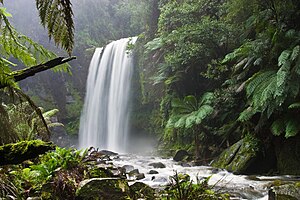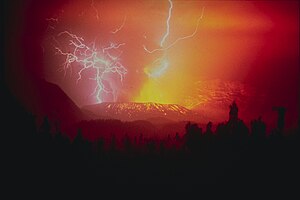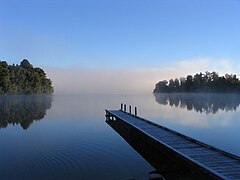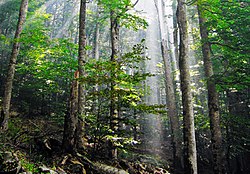Природа — разлика између измена
+ |
. |
||
| Ред 1: | Ред 1: | ||
{{Multiple image |
|||
[[Датотека:Hopetoun falls.jpg|300п|мини|Слика из природе]] |
|||
| direction = vertical |
|||
[[Датотека:Galunggung.jpg|thumb|right|300px|Удар [[муња|муње]] током ерупције [[вулкан]]а [[Галунгунг]]а на [[Западна Јава|Западној Јави]] 1982.]] |
|||
| image1 = Hopetoun falls.jpg |
|||
| width1 = 300 |
|||
| caption1 = [[Hopetoun falls|Хоуптаун водопади]], Аустралија |
|||
| image2 = Bachalpsee reflection.jpg |
|||
| width2 = 300 |
|||
| caption2 = Језеро у [[Швајцарски Алпи|Швајцарским Алпима]] |
|||
| image3 = Galunggung.jpg |
|||
| width3 = 300 |
|||
| caption3 = Удар [[муња|муње]] током ерупције [[вулкан]]а [[Галунгунг]]а на [[Западна Јава|Западној Јави]] 1982. |
|||
| image4 = KERALA - 32.jpg |
|||
| width4 = 300 |
|||
| caption4 = Путеви у [[Керала|Керали]] |
|||
}} |
|||
{{рут}} |
|||
'''Природа''' је, у најширем смислу, еквивалент '''природном свету''', '''физичком универзуму''', '''материјалном свету''' или '''материјалном универзуму'''. ''Природа'' се односи на [[појава|феномен]] физичког света, као и на живот уопште. Њезин распон сеже од [[субатомска честица|субатомског]] до [[свемир|космичког]]. Израз обично не укључује произведене објекте, као ни људску интеракцију, осим ако се тако квалификује, као на пример ''људска природа''. Појам ''природе'' и ''природног'' је такође супротан појму ''натприродног''. |
'''Природа''' је, у најширем смислу, еквивалент '''природном свету''', '''физичком универзуму''', '''материјалном свету''' или '''материјалном универзуму'''. ''Природа'' се односи на [[појава|феномен]] физичког света, као и на живот уопште. Њезин распон сеже од [[субатомска честица|субатомског]] до [[свемир|космичког]]. Израз обично не укључује произведене објекте, као ни људску интеракцију, осим ако се тако квалификује, као на пример ''људска природа''. Појам ''природе'' и ''природног'' је такође супротан појму ''натприродног''. |
||
| Ред 11: | Ред 24: | ||
{{Хронологија природе}} |
{{Хронологија природе}} |
||
{{Main article|Земља|Науке о Земљи}} |
{{Main article|Земља|Науке о Земљи}} |
||
[[Датотека:The Earth seen from Apollo 17.jpg|thumb|left| |
[[Датотека:The Earth seen from Apollo 17.jpg|thumb|left|250px|Поглед на [[Земља|Земљу]], који је 1972. године направила посада [[Аполо 17|Апола 17]].]] |
||
Земља је једина [[планет]]а за који је познато да подржава живот, и њена природна својства су предмет многих поља научних истраживања. Унутар [[Соларни систем|соларног система]], она је трећа планате по удаљености од Сунца. Она је највећа [[терестричка планета]] и пета по величини свеукупно. Најпроминентнија климатска својстава земље су њена два велика поларна региона, две релативно уске [[Умерена клима|умерене]] зоне, и широки [[екватор]]ијални тропски до [[Суптропска клима|субтропског]] региона.<ref>{{cite web |
Земља је једина [[планет]]а за који је познато да подржава живот, и њена природна својства су предмет многих поља научних истраживања. Унутар [[Соларни систем|соларног система]], она је трећа планате по удаљености од Сунца. Она је највећа [[терестричка планета]] и пета по величини свеукупно. Најпроминентнија климатска својстава земље су њена два велика поларна региона, две релативно уске [[Умерена клима|умерене]] зоне, и широки [[екватор]]ијални тропски до [[Суптропска клима|субтропског]] региона.<ref>{{cite web |
||
| Ред 23: | Ред 36: | ||
[[Атмосфера|Атмосферски]] услови су се знатно изменили у односу на оригиналне услове услед присуства животни форми,<ref>{{cite web|date = 11. 9. 2005|url = http://www.sciencedaily.com/releases/2005/09/050911103921.htm|title = Calculations favor reducing atmosphere for early Earth|work=[[Science Daily]]|accessdate = 6. 1. 2007.}}</ref> које креирају еколошки баланс и стабилизују површинске услове. Упркос широког опсега регионалних варијација климе дуж [[латитуда|латитуде]] и других географских фактора, дугорочни просек глобалне климе је веома стабилан током међуледених периода,<ref>{{cite web|url = http://www.epa.gov/climatechange/science/pastcc.html|title = Past Climate Change|publisher = U.S. Environmental Protection Agency|accessdate = 7. 1. 2007.}}</ref> и варијације од једног или два степена просечне глобалне температуре су историјски имале велике учинке на еколошки баланс, и на саму географију Земље.<ref>{{cite web|last=Anderson|first=Hugh|last2=Walter|first2=Bernard|date = 28. 3. 1997|url = http://vathena.arc.nasa.gov/curric/land/global/climchng.html |title = History of Climate Change|publisher = NASA|accessdate = 7. 1. 2007. |archiveurl = https://web.archive.org/web/20080123130745/http://vathena.arc.nasa.gov/curric/land/global/climchng.html |archivedate = 23. 1. 2008}}</ref><ref>{{cite web|last = Weart|first = Spencer |date= 2006|url = http://www.aip.org/history/climate/|title = The Discovery of Global Warming|publisher = American Institute of Physics|accessdate = 7. 1. 2007. }}</ref> |
[[Атмосфера|Атмосферски]] услови су се знатно изменили у односу на оригиналне услове услед присуства животни форми,<ref>{{cite web|date = 11. 9. 2005|url = http://www.sciencedaily.com/releases/2005/09/050911103921.htm|title = Calculations favor reducing atmosphere for early Earth|work=[[Science Daily]]|accessdate = 6. 1. 2007.}}</ref> које креирају еколошки баланс и стабилизују површинске услове. Упркос широког опсега регионалних варијација климе дуж [[латитуда|латитуде]] и других географских фактора, дугорочни просек глобалне климе је веома стабилан током међуледених периода,<ref>{{cite web|url = http://www.epa.gov/climatechange/science/pastcc.html|title = Past Climate Change|publisher = U.S. Environmental Protection Agency|accessdate = 7. 1. 2007.}}</ref> и варијације од једног или два степена просечне глобалне температуре су историјски имале велике учинке на еколошки баланс, и на саму географију Земље.<ref>{{cite web|last=Anderson|first=Hugh|last2=Walter|first2=Bernard|date = 28. 3. 1997|url = http://vathena.arc.nasa.gov/curric/land/global/climchng.html |title = History of Climate Change|publisher = NASA|accessdate = 7. 1. 2007. |archiveurl = https://web.archive.org/web/20080123130745/http://vathena.arc.nasa.gov/curric/land/global/climchng.html |archivedate = 23. 1. 2008}}</ref><ref>{{cite web|last = Weart|first = Spencer |date= 2006|url = http://www.aip.org/history/climate/|title = The Discovery of Global Warming|publisher = American Institute of Physics|accessdate = 7. 1. 2007. }}</ref> |
||
===Геологија=== |
|||
{{Main article|Геологија}} |
|||
Геологија је наука и студија чврсте и течне материје од које се састоји [[Земља]]. The field of geology encompasses the study of the composition, [[structural geology|structure]], [[Physical property|physical properties]], dynamics, and [[History of the Earth|history]] of [[Earth materials]], and the processes by which they are formed, moved, and changed. The field is a major [[academic discipline]], and is also important for [[mining|mineral]] and [[petroleum geology|hydrocarbon]] extraction, knowledge about and mitigation of [[natural hazard]]s, some [[Geotechnical engineering]] fields, and understanding [[Paleoclimatology|past climates]] and environments. |
|||
==== Геолошка еволуција ==== |
|||
[[Датотека:Tectonic plate boundaries.png|thumb|left|250px|Три типа геолошких [[Тектоника плоча|тектонских]] граница.]] |
|||
The geology of an area evolves through time as rock units are deposited and inserted and deformational processes change their shapes and locations. |
|||
Rock units are first emplaced either by [[deposition (geology)|deposition]] onto the surface or intrude into the [[Country rock (geology)|overlying rock]]. Deposition can occur when [[sediment]]s settle onto the surface of the Earth and later [[lithification|lithify]] into [[sedimentary rock]], or when as [[volcanic rock|volcanic material]] such as [[volcanic ash]] or [[lava]] flows, blanket the surface. Igneous [[intrusion]]s such as [[batholith]]s, [[laccolith]]s, [[dike (geology)|dikes]], and [[sill (geology)|sills]], push upwards into the overlying rock, and crystallize as they intrude. |
|||
After the initial sequence of rocks has been deposited, the rock units can be [[deformation (mechanics)|deformed]] and/or [[metamorphism|metamorphosed]]. Deformation typically occurs as a result of horizontal shortening, [[extension (geology)|horizontal extension]], or side-to-side ([[strike-slip]]) motion. These structural regimes broadly relate to [[convergent boundary|convergent boundaries]], [[divergent boundary|divergent boundaries]], and [[transform boundary|transform boundaries]], respectively, between [[plate tectonics|tectonic plates]]. |
|||
=== Историјска перспектива === |
|||
{{Main article|Историја Земље|Еволуција}} |
|||
[[Датотека:Pangea animation 03.gif|thumb|250px|Анимација приказује кретање континената од сепарације континента [[Пангеа]] до данашњег дана.]] |
|||
Earth is estimated to have formed 4.54 billion years ago from the [[solar nebula]], along with the [[Sun]] and other [[planet]]s.<ref>{{cite book |first=G. Brent |last=Dalrymple |date=1991 |title=The Age of the Earth |publisher=Stanford University Press |location=Stanford |isbn=0-8047-1569-6}}</ref> The moon formed roughly 20 million years later. Initially molten, the outer layer of the Earth cooled, resulting in the solid crust. Outgassing and [[Volcano|volcanic]] activity produced the primordial atmosphere. Condensing [[water vapor]], most or all of which came from [[ice]] delivered by [[comet]]s, [[Origin of water on Earth|produced the oceans]] and other water sources.<ref> |
|||
{{cite journal |
|||
|first=A. |
|||
|last=Morbidelli |
|||
|display-authors=etal |
|||
|date=2000 |
|||
|bibcode=2000M&PS...35.1309M |
|||
|title=Source Regions and Time Scales for the Delivery of Water to Earth |
|||
|journal=Meteoritics & Planetary Science |
|||
|volume=35 |
|||
|issue=6 |
|||
|pages=1309–1320 |
|||
|doi=10.1111/j.1945-5100.2000.tb01518.x |
|||
}}</ref> The highly energetic chemistry is believed to have produced a self-replicating molecule around 4 billion years ago.<ref> |
|||
{{cite news |
|||
|title=Earth's Oldest Mineral Grains Suggest an Early Start for Life |
|||
|publisher=NASA Astrobiology Institute |
|||
|date=December 24, 2001 |
|||
|url=http://nai.arc.nasa.gov/news_stories/news_detail.cfm?ID=76 |
|||
|accessdate=2006-05-24 |
|||
|deadurl=yes |
|||
|archiveurl=https://web.archive.org/web/20060928231649/http://nai.arc.nasa.gov/news_stories/news_detail.cfm?ID=76 |
|||
|archivedate=September 28, 2006 |
|||
|df=mdy-all |
|||
}}</ref> |
|||
[[Датотека:Hyperia.jpg|thumb|left|250px|[[Планктон]] настањује океане, мора и језера, и постојао је у разним формама бар задње 2 милијарде година.<ref name="Margulis1995">{{cite book|last=Margulis|first=Lynn|author2=Dorian Sagan |date=1995|title=What is Life?|publisher=Simon & Schuster|location=New York|isbn=0-684-81326-2}}</ref>]] |
|||
Continents formed, then broke up and reformed as the surface of Earth reshaped over hundreds of millions of years, occasionally combining to make a [[supercontinent]]. Roughly 750 million years ago, the earliest known supercontinent [[Rodinia]], began to break apart. The continents later recombined to form [[Pannotia]] which broke apart about 540 million years ago, then finally [[Pangaea]], which broke apart about 180 million years ago.<ref>{{cite journal |first=J.B. |last=Murphy |author2=R.D. Nance |date=2004 |url=http://www.americanscientist.org/issues/page2/how-do-supercontinents-assemble |title=How do supercontinents assemble? |journal=American Scientist |volume=92 |issue=4 |doi=10.1511/2004.4.324|page = 324}}</ref> |
|||
During the [[Neoproterozoic]] era covered much of the Earth in [[glacier]]s and ice sheets. This hypothesis has been termed the "[[Snowball Earth]]", and it is of particular interest as it precedes the [[Cambrian explosion]] in which multicellular life forms began to proliferate about 530–540 million years ago.<ref>{{cite book |first=J.L. |last=Kirschvink |date=1992 |chapter=Late Proterozoic Low-Latitude Global Glaciation: The Snowball Earth |chapterurl=http://www.gps.caltech.edu/~jkirschvink/pdfs/firstsnowball.pdf |title=The Proterozoic Biosphere |editor=J.W. Schopf |editor2=C. Klein |publisher=Cambridge University Press |location=Cambridge |pages=51–52 |isbn=0-521-36615-1}}</ref> |
|||
Since the Cambrian explosion there have been five distinctly identifiable [[Extinction event|mass extinctions]].<ref>{{cite journal |last=Raup |first=David M. |author2=J. John Sepkoski Jr. |date=March 1982 |title=Mass extinctions in the marine fossil record |journal=Science |volume=215 |issue=4539|pages = 1501–3 |doi=10.1126/science.215.4539.1501 |pmid=17788674 |bibcode=1982Sci...215.1501R}}</ref> The last mass extinction occurred some 66 million years ago, when a meteorite collision probably triggered the extinction of the [[Bird|non-avian]] [[dinosaur]]s and other large reptiles, but spared small animals such as [[mammal]]s. Over the past 66 million years, mammalian life diversified.<ref>{{cite book |last=Margulis |first=Lynn |author2=Dorian Sagan |date=1995 |title=What is Life? |publisher=Simon & Schuster |location=New York |isbn=0-684-81326-2 |page=145}}</ref> |
|||
Several million years ago, a species of small African [[ape]] gained the ability to stand upright.<ref name="Margulis1995" /> The subsequent advent of human life, and the development of agriculture and further [[civilization]] allowed humans to affect the Earth more rapidly than any previous life form, affecting both the nature and quantity of other organisms as well as global climate. By comparison, the [[Great Oxygenation Event]], produced by the proliferation of [[algae]] during the [[Siderian]] period, required about 300 million years to culminate. |
|||
The present era is classified as part of a mass [[extinction event]], the [[Holocene extinction]] event, the fastest ever to have occurred.<ref>{{cite journal|author = Diamond J|title = The present, past and future of human-caused extinctions|journal = Philos Trans R Soc Lond B Biol Sci|volume = 325|issue = 1228|pages = 469–76; discussion 476–7|date = 1989|pmid = 2574887|doi = 10.1098/rstb.1989.0100|last2 = Ashmole|first2 = N. P.|last3 = Purves|first3 = P. E.|bibcode = 1989RSPTB.325..469D}}</ref><ref>{{cite journal|author = Novacek M|author2 = Cleland E|title = The current biodiversity extinction event: scenarios for mitigation and recovery|journal = Proc Natl Acad Sci USA|volume = 98|issue = 10|date = 2001|pmid = 11344295|doi = 10.1073/pnas.091093698|pmc = 33235|bibcode = 2001PNAS...98.5466N|pages = 5466–70}}</ref> Some, such as [[E. O. Wilson]] of [[Harvard University]], predict that human destruction of the [[biosphere]] could cause the extinction of one-half of all species in the next 100 years.<ref>{{cite journal|title=The mid-Holocene extinction of silver fir (Abies alba) in the Southern Alps: a consequence of forest fires? Palaeobotanical records and forest simulations|doi=10.1007/s00334-006-0051-0|date=2006|last1=Wick|first1=Lucia|last2=Möhl|first2=Adrian|journal=Vegetation History and Archaeobotany|volume=15|issue=4|pages=435–444}}</ref> The extent of the current extinction event is still being researched, debated and calculated by biologists.<ref>[http://park.org/Canada/Museum/extinction/holmass.html The Holocene Extinction]. Park.org. Retrieved on 2016-11-03.</ref><ref>[http://park.org/Canada/Museum/extinction/extincmenu.html Mass Extinctions Of The Phanerozoic Menu]. Park.org. Retrieved on 2016-11-03.</ref><ref>[http://park.org/Canada/Museum/extinction/patterns.html Patterns of Extinction]. Park.org. Retrieved on 2016-11-03.</ref> |
|||
==Атмосфера, клима, и време== |
|||
[[Датотека:Top of Atmosphere.jpg|thumb|250px|[[Рејлијево расејање|Плаво светло се расипа више]] од других таласних дужина посредством гасова у [[атмосфера|атмосфери]], дајући Земљи плави [[Halo (optical phenomenon)|хало]] кад се гледа из васионе]] |
|||
{{Main article|Земљина атмосфера|клима|време}} |
|||
Земљина атмосфера је кључни фактор у одржавању [[Природа#Екосистеми|екосистема]]. The thin layer of gases that envelops the Earth is held in place by gravity. Air is mostly [[nitrogen]], [[oxygen]], [[water vapor]], with much smaller amounts of carbon dioxide, argon, etc. The atmospheric pressure declines steadily with altitude. The [[ozone layer]] plays an important role in depleting the amount of [[ultraviolet]] (UV) radiation that reaches the surface. As [[DNA]] is readily damaged by UV light, this serves to protect life at the surface. The atmosphere also retains heat during the night, thereby reducing the daily temperature extremes. |
|||
Terrestrial weather occurs almost exclusively in the [[troposphere|lower part of the atmosphere]], and serves as a convective system for redistributing heat.<ref>{{Cite book|url=https://books.google.com/?id=AJ4SnHbb-ZcC&pg=PA42|title=Environmental Science: Problems, Connections and Solutions|last=Miller|first=G.|last2=Spoolman|first2=Scott|date=2007-09-28|publisher=Cengage Learning|isbn=0495383376}}</ref> [[Ocean current]]s are another important factor in determining climate, particularly the major underwater [[thermohaline circulation]] which distributes heat energy from the equatorial oceans to the polar regions. These currents help to moderate the differences in temperature between winter and summer in the temperate zones. Also, without the redistributions of heat energy by the ocean currents and atmosphere, the tropics would be much hotter, and the [[polar region]]s much colder. |
|||
[[Датотека:Lightnings sequence 2 animation-wcag.gif|thumb|left|250px|[[Муња]]]] |
|||
Weather can have both beneficial and harmful effects. Extremes in weather, such as [[tornado]]es or [[hurricane]]s and [[cyclone]]s, can expend large amounts of energy along their paths, and produce devastation. Surface vegetation has evolved a dependence on the seasonal variation of the weather, and sudden changes lasting only a few years can have a dramatic effect, both on the vegetation and on the animals which depend on its growth for their food. |
|||
Climate is a measure of the long-term trends in the weather. Various factors are known to [[Climate change|influence the climate]], including ocean currents, surface [[albedo]], [[greenhouse gas]]es, variations in the solar luminosity, and changes to the Earth's orbit. Based on historical records, the Earth is known to have undergone drastic climate changes in the past, including [[ice age]]s. |
|||
[[Датотека:Dszpics1.jpg|thumb|250px|лево|Торнадо у централној [[Оклахома|Оклахоми]]]] |
|||
The climate of a region depends on a number of factors, especially [[latitude]]. A latitudinal band of the surface with similar climatic attributes forms a climate region. There are a number of such regions, ranging from the [[tropical climate]] at the equator to the [[polar climate]] in the northern and southern extremes. Weather is also influenced by the seasons, which result from the [[Earth]]'s [[axis of rotation|axis]] being [[axial tilt|tilted]] relative to its [[orbital plane (astronomy)|orbital plane]]. Thus, at any given time during the summer or winter, one part of the Earth is more directly exposed to the rays of the [[sun]]. This exposure alternates as the Earth revolves in its orbit. At any given time, regardless of season, the [[northern hemisphere|northern]] and [[southern hemisphere|southern]] hemispheres experience opposite seasons. |
|||
Weather is a [[Chaos theory|chaotic system]] that is readily modified by small changes to the [[Natural environment|environment]], so accurate [[Meteorology|weather forecasting]] is limited to only a few days.{{Citation needed|date=April 2010}} Overall, two things are happening worldwide: (1) temperature is increasing on the average; and (2) regional climates have been undergoing noticeable changes.<ref>{{cite news|title=Tropical Ocean Warming Drives Recent Northern Hemisphere Climate Change|publisher=Science Daily|date=April 6, 2001|url=http://www.sciencedaily.com/releases/2001/04/010406073554.htm|accessdate=2006-05-24}}</ref> |
|||
== Материја и енергија == |
|||
[[Датотека:Hydrogen Density Plots.png|thumb|250px|Првих неколоко [[Атомска орбитала|електронских орбитала]] [[Водоник|водониковог атома]] приказаних као попречни пресеци са бојом-кодираном густином вероватноће]] |
|||
{{Main article|материја|енергија}} |
|||
Some fields of science see nature as matter in motion, obeying certain laws of nature which science seeks to understand. For this reason the most fundamental science is generally understood to be "[[physics]]" – the name for which is still recognizable as meaning that it is the study of nature. |
|||
Matter is commonly defined as the substance of which physical objects are composed. It constitutes the [[observable universe]]. The visible components of the universe are now believed to compose only 4.9 percent of the total mass. The remainder is believed to consist of 26.8 percent [[cold dark matter]] and 68.3 percent [[dark energy]].<ref name="planck_overview">{{cite journal |title=Planck 2013 results. I. Overview of products and scientific results – Table 9. |journal=[[Astronomy and Astrophysics]] |first1=P. A. R. |last1=Ade |first2=N. |last2=Aghanim |first3=C. |last3=Armitage-Caplan |last4=et al. (Planck Collaboration) |date=March 22, 2013 |arxiv=1303.5062|bibcode = 2014A&A...571A...1P |doi=10.1051/0004-6361/201321529 |volume=571 |pages=A1}}</ref> The exact arrangement of these components is still unknown and is under intensive investigation by physicists. |
|||
The behavior of matter and energy throughout the observable universe appears to follow well-defined [[physical law]]s. These laws have been employed to produce [[Physical cosmology|cosmological]] models that successfully explain the structure and the evolution of the universe we can observe. The mathematical expressions of the laws of physics employ a set of twenty [[physical constant]]s<ref>{{cite web|last = Taylor|first = Barry N.|date = 1971|url = http://www.physics.nist.gov/cuu/Constants/introduction.html|title = Introduction to the constants for nonexperts|publisher = National Institute of Standards and Technology|accessdate = 2007-01-07 |
|||
}}</ref> that appear to be static across the observable universe.<ref>{{cite journal|author=Varshalovich, D. A.|author2=Potekhin, A. Y.|author3=Ivanchik, A. V. |last-author-amp=yes|title=Testing cosmological variability of fundamental constants|journal=AIP Conference Proceedings|date=2000|volume=506|page=503|arxiv=physics/0004062|doi=10.1063/1.1302777|series=AIP Conference Proceedings|bibcode=2000AIPC..506..503V}}</ref> The values of these constants have been carefully measured, but the reason for their specific values remains a mystery. |
|||
== Галерија == |
== Галерија == |
||
<gallery> |
<gallery widths="250px" heights="180px" > |
||
Датотека:NGC 4414 (NASA-med).jpg|[[Спирална галаксија]] |
Датотека:NGC 4414 (NASA-med).jpg|[[Спирална галаксија]] |
||
Датотека:A_storm_at_Pors-Loubous.jpg|[[Талас]]и |
Датотека:A_storm_at_Pors-Loubous.jpg|[[Талас]]и |
||
Датотека:Dszpics1.jpg|[[Торнадо]] |
|||
Датотека:Lake mapourika NZ.jpeg|Језеро Мапоурика на [[Нови Зеланд|Новом Зеланду]] |
Датотека:Lake mapourika NZ.jpeg|Језеро Мапоурика на [[Нови Зеланд|Новом Зеланду]] |
||
Датотека:Biogradska suma.jpg|Биоградска шума у [[Црна Гора|Црној Гори]] |
Датотека:Biogradska suma.jpg|Биоградска шума у [[Црна Гора|Црној Гори]] |
||
Верзија на датум 18. јануар 2018. у 06:54
Један корисник управо ради на овом чланку. Молимо остале кориснике да му допусте да заврши са радом. Ако имате коментаре и питања у вези са чланком, користите страницу за разговор.
Хвала на стрпљењу. Када радови буду завршени, овај шаблон ће бити уклоњен. Напомене
|
Природа је, у најширем смислу, еквивалент природном свету, физичком универзуму, материјалном свету или материјалном универзуму. Природа се односи на феномен физичког света, као и на живот уопште. Њезин распон сеже од субатомског до космичког. Израз обично не укључује произведене објекте, као ни људску интеракцију, осим ако се тако квалификује, као на пример људска природа. Појам природе и природног је такође супротан појму натприродног.
Латинска реч за природу или нарав је natura, тј. „есенцијални квалитет, урођена диспозиција“, а у древна је времена дословно значила „рођење“.[1] Natura је латински превод грчке речи physis (φύσις), која се изворно повезивала с интринзичним карактеристикама које биљке, животиње и остале особине света развијају у складу са собом.[2][3] Концепт природе у целини, физички свемир, један је од неколико проширења изворне идеје; предсократски филозофи почели су примењивати реч φύσις у одређеном језгровитом значењу и отада је она почела стицати своје значење. Ова је употреба била потврђена доласком модерне научне методе током последњих неколико векова.[4][5]
Данас у разним употребама ове речи „природа“ често означава геологију и дивљину. Природа може означивати опште царство разних типова живућих биљака и животиња, а у неким случајевима процесе повезане с неживим објектима – начин на који поједини типови ствари постоје и мењају се у складу са собом, попут времена и геологије Земље, те материје и енергије од којих су све ствари састављене. Често се под природом подразумева „природни околиш“ или дивљина коју чине дивље животиње, стене, шуме, плаже и уопштено све ствари које нису знатно измењене човековом интервенцијом или оне које трају успркос човекове интервенције. На пример, израђени предмети и човекова интеракција уопштено се не сматрају делом природе осим ако нису, на пример, означени као „људска природа“ или „читава природа“. Овај традиционалнији концепт природних ствари, који се још може срести, имплицира разликовање природног и вештачког тако да се вештачко схвата као оно што је настало човековом свешћу или човековим умом. Зависно од појединог контекста појам „природан“ или „нараван“ може се такође разликовати од неприродног (ненаравног), натприродног (наднаравног) или синтетског.
Земља
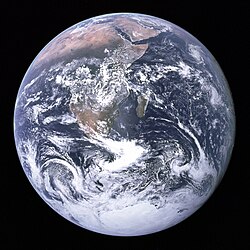
Земља је једина планета за који је познато да подржава живот, и њена природна својства су предмет многих поља научних истраживања. Унутар соларног система, она је трећа планате по удаљености од Сунца. Она је највећа терестричка планета и пета по величини свеукупно. Најпроминентнија климатска својстава земље су њена два велика поларна региона, две релативно уске умерене зоне, и широки екваторијални тропски до субтропског региона.[6] Падавине широко варирају са локацијом, од неколико метара воде годишње до неколико милиметара. 71 проценат земљине површине је покривен океанима са сланом водом. Остатак се састоји од континената и острва, при чему је највећи де насељиве територије на Северној хемисфери.
Земља је еволуирала кроз геолошке и биолошке процесе који су оставили трагове оригиналних околности. Спољашња површина је подељена у неколико постепено мигрирајућих тектонских плоча. Унутрашњост је и даље активна, са дебелим слојем пластичног мантла и са језгром испуњеним гвожђем које генерише магнетно поље. То гвоздено језгоро се састоји од чврсте унутрашње фазе, и течне спољашње фазе. Конвективно кретање у језгру генерише електричне струје путем динамо дејства, и оне затим генеришу геомагнетно поље.
Атмосферски услови су се знатно изменили у односу на оригиналне услове услед присуства животни форми,[7] које креирају еколошки баланс и стабилизују површинске услове. Упркос широког опсега регионалних варијација климе дуж латитуде и других географских фактора, дугорочни просек глобалне климе је веома стабилан током међуледених периода,[8] и варијације од једног или два степена просечне глобалне температуре су историјски имале велике учинке на еколошки баланс, и на саму географију Земље.[9][10]
Геологија
Геологија је наука и студија чврсте и течне материје од које се састоји Земља. The field of geology encompasses the study of the composition, structure, physical properties, dynamics, and history of Earth materials, and the processes by which they are formed, moved, and changed. The field is a major academic discipline, and is also important for mineral and hydrocarbon extraction, knowledge about and mitigation of natural hazards, some Geotechnical engineering fields, and understanding past climates and environments.
Геолошка еволуција
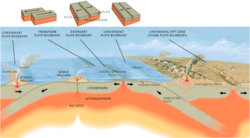
The geology of an area evolves through time as rock units are deposited and inserted and deformational processes change their shapes and locations.
Rock units are first emplaced either by deposition onto the surface or intrude into the overlying rock. Deposition can occur when sediments settle onto the surface of the Earth and later lithify into sedimentary rock, or when as volcanic material such as volcanic ash or lava flows, blanket the surface. Igneous intrusions such as batholiths, laccoliths, dikes, and sills, push upwards into the overlying rock, and crystallize as they intrude.
After the initial sequence of rocks has been deposited, the rock units can be deformed and/or metamorphosed. Deformation typically occurs as a result of horizontal shortening, horizontal extension, or side-to-side (strike-slip) motion. These structural regimes broadly relate to convergent boundaries, divergent boundaries, and transform boundaries, respectively, between tectonic plates.
Историјска перспектива

Earth is estimated to have formed 4.54 billion years ago from the solar nebula, along with the Sun and other planets.[11] The moon formed roughly 20 million years later. Initially molten, the outer layer of the Earth cooled, resulting in the solid crust. Outgassing and volcanic activity produced the primordial atmosphere. Condensing water vapor, most or all of which came from ice delivered by comets, produced the oceans and other water sources.[12] The highly energetic chemistry is believed to have produced a self-replicating molecule around 4 billion years ago.[13]
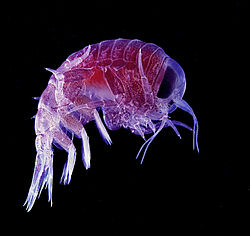
Continents formed, then broke up and reformed as the surface of Earth reshaped over hundreds of millions of years, occasionally combining to make a supercontinent. Roughly 750 million years ago, the earliest known supercontinent Rodinia, began to break apart. The continents later recombined to form Pannotia which broke apart about 540 million years ago, then finally Pangaea, which broke apart about 180 million years ago.[15]
During the Neoproterozoic era covered much of the Earth in glaciers and ice sheets. This hypothesis has been termed the "Snowball Earth", and it is of particular interest as it precedes the Cambrian explosion in which multicellular life forms began to proliferate about 530–540 million years ago.[16]
Since the Cambrian explosion there have been five distinctly identifiable mass extinctions.[17] The last mass extinction occurred some 66 million years ago, when a meteorite collision probably triggered the extinction of the non-avian dinosaurs and other large reptiles, but spared small animals such as mammals. Over the past 66 million years, mammalian life diversified.[18]
Several million years ago, a species of small African ape gained the ability to stand upright.[14] The subsequent advent of human life, and the development of agriculture and further civilization allowed humans to affect the Earth more rapidly than any previous life form, affecting both the nature and quantity of other organisms as well as global climate. By comparison, the Great Oxygenation Event, produced by the proliferation of algae during the Siderian period, required about 300 million years to culminate.
The present era is classified as part of a mass extinction event, the Holocene extinction event, the fastest ever to have occurred.[19][20] Some, such as E. O. Wilson of Harvard University, predict that human destruction of the biosphere could cause the extinction of one-half of all species in the next 100 years.[21] The extent of the current extinction event is still being researched, debated and calculated by biologists.[22][23][24]
Атмосфера, клима, и време

Земљина атмосфера је кључни фактор у одржавању екосистема. The thin layer of gases that envelops the Earth is held in place by gravity. Air is mostly nitrogen, oxygen, water vapor, with much smaller amounts of carbon dioxide, argon, etc. The atmospheric pressure declines steadily with altitude. The ozone layer plays an important role in depleting the amount of ultraviolet (UV) radiation that reaches the surface. As DNA is readily damaged by UV light, this serves to protect life at the surface. The atmosphere also retains heat during the night, thereby reducing the daily temperature extremes.
Terrestrial weather occurs almost exclusively in the lower part of the atmosphere, and serves as a convective system for redistributing heat.[25] Ocean currents are another important factor in determining climate, particularly the major underwater thermohaline circulation which distributes heat energy from the equatorial oceans to the polar regions. These currents help to moderate the differences in temperature between winter and summer in the temperate zones. Also, without the redistributions of heat energy by the ocean currents and atmosphere, the tropics would be much hotter, and the polar regions much colder.

Weather can have both beneficial and harmful effects. Extremes in weather, such as tornadoes or hurricanes and cyclones, can expend large amounts of energy along their paths, and produce devastation. Surface vegetation has evolved a dependence on the seasonal variation of the weather, and sudden changes lasting only a few years can have a dramatic effect, both on the vegetation and on the animals which depend on its growth for their food.
Climate is a measure of the long-term trends in the weather. Various factors are known to influence the climate, including ocean currents, surface albedo, greenhouse gases, variations in the solar luminosity, and changes to the Earth's orbit. Based on historical records, the Earth is known to have undergone drastic climate changes in the past, including ice ages.
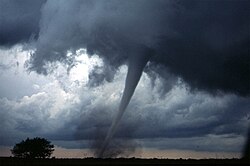
The climate of a region depends on a number of factors, especially latitude. A latitudinal band of the surface with similar climatic attributes forms a climate region. There are a number of such regions, ranging from the tropical climate at the equator to the polar climate in the northern and southern extremes. Weather is also influenced by the seasons, which result from the Earth's axis being tilted relative to its orbital plane. Thus, at any given time during the summer or winter, one part of the Earth is more directly exposed to the rays of the sun. This exposure alternates as the Earth revolves in its orbit. At any given time, regardless of season, the northern and southern hemispheres experience opposite seasons.
Weather is a chaotic system that is readily modified by small changes to the environment, so accurate weather forecasting is limited to only a few days.[тражи се извор] Overall, two things are happening worldwide: (1) temperature is increasing on the average; and (2) regional climates have been undergoing noticeable changes.[26]
Материја и енергија

Some fields of science see nature as matter in motion, obeying certain laws of nature which science seeks to understand. For this reason the most fundamental science is generally understood to be "physics" – the name for which is still recognizable as meaning that it is the study of nature.
Matter is commonly defined as the substance of which physical objects are composed. It constitutes the observable universe. The visible components of the universe are now believed to compose only 4.9 percent of the total mass. The remainder is believed to consist of 26.8 percent cold dark matter and 68.3 percent dark energy.[27] The exact arrangement of these components is still unknown and is under intensive investigation by physicists.
The behavior of matter and energy throughout the observable universe appears to follow well-defined physical laws. These laws have been employed to produce cosmological models that successfully explain the structure and the evolution of the universe we can observe. The mathematical expressions of the laws of physics employ a set of twenty physical constants[28] that appear to be static across the observable universe.[29] The values of these constants have been carefully measured, but the reason for their specific values remains a mystery.
Галерија
-
Језеро Мапоурика на Новом Зеланду
-
Биоградска шума у Црној Гори
Види још
Референце
- ^ Harper, Douglas. "nature". Online Etymology Dictionary. Pristupljeno 23. 9. 2006.
- ^ Користан премда донекле погрешно представљен приказ предсократског поређења концепта φύσις може се наћи у Надаф, Герардовом The Greek Concept of Nature, SUNY Press, 2006. Реч φύσις, премда први пут упорабљена у вези с биљком код Хомера, јавља се врло рано у грчкој филозофији и у неколико значења. Ова се значења уопштено подударају с тренутним значењима у којима се реч природа или нарав користи, као што је потврђено у Guthrie, W. K. C. Presocratic Tradition from Parmenides to Democritus (други том његовог дела History of Greek Philosophy), Cambridge UP, 1965.
- ^ Прва позната употреба речи physis забележена је код Хомера као референца на интринзичне квалитете биљке: ὣς ἄρα φωνήσας πόρε φάρμακον ἀργεϊφόντης ἐκ γαίης ἐρύσας, καί μοι φύσιν αὐτοῦ ἔδειξε. (So saying, Argeiphontes [=Hermes] gave me the herb, drawing it from the ground, and showed me its nature.) Odyssey 10.302-3 (ed. A. T. Murray). (О речи се подробније говори у Лиделовом и Скотовом делу Greek Lexicon.) За каснију, али још врло рану грчку употребу овог појма види претходну белешку.
- ^ Philosophiae Naturalis Principia Mathematica (1687) Исака Њутна преводи се, на пример, као „Математички принципи природне филозофије“, а одражава тадашњу савремену употребу речи „природне филозофије“ што је сродно „саставном проучавању природе“
- ^ Етимологија речи „физички“ указује на њезину употребу као синоним за „природно“ већ од око средине 15. века: Harper, Douglas. "physical". Online Etymology Dictionary. Приступљено 20. 9. 2006.
- ^ „World Climates”. Blue Planet Biomes. Приступљено 21. 9. 2006.
- ^ „Calculations favor reducing atmosphere for early Earth”. Science Daily. 11. 9. 2005. Приступљено 6. 1. 2007.
- ^ „Past Climate Change”. U.S. Environmental Protection Agency. Приступљено 7. 1. 2007.
- ^ Anderson, Hugh; Walter, Bernard (28. 3. 1997). „History of Climate Change”. NASA. Архивирано из оригинала 23. 1. 2008. г. Приступљено 7. 1. 2007.
- ^ Weart, Spencer (2006). „The Discovery of Global Warming”. American Institute of Physics. Приступљено 7. 1. 2007.
- ^ Dalrymple, G. Brent (1991). The Age of the Earth. Stanford: Stanford University Press. ISBN 0-8047-1569-6.
- ^ Morbidelli, A.; et al. (2000). „Source Regions and Time Scales for the Delivery of Water to Earth”. Meteoritics & Planetary Science. 35 (6): 1309—1320. Bibcode:2000M&PS...35.1309M. doi:10.1111/j.1945-5100.2000.tb01518.x.
- ^ „Earth's Oldest Mineral Grains Suggest an Early Start for Life”. NASA Astrobiology Institute. 24. 12. 2001. Архивирано из оригинала 28. 9. 2006. г. Приступљено 2006-05-24.
- ^ а б Margulis, Lynn; Dorian Sagan (1995). What is Life?. New York: Simon & Schuster. ISBN 0-684-81326-2.
- ^ Murphy, J.B.; R.D. Nance (2004). „How do supercontinents assemble?”. American Scientist. 92 (4): 324. doi:10.1511/2004.4.324.
- ^ Kirschvink, J.L. (1992). „Late Proterozoic Low-Latitude Global Glaciation: The Snowball Earth” (PDF). Ур.: J.W. Schopf; C. Klein. The Proterozoic Biosphere. Cambridge: Cambridge University Press. стр. 51—52. ISBN 0-521-36615-1.
- ^ Raup, David M.; J. John Sepkoski Jr. (март 1982). „Mass extinctions in the marine fossil record”. Science. 215 (4539): 1501—3. Bibcode:1982Sci...215.1501R. PMID 17788674. doi:10.1126/science.215.4539.1501.
- ^ Margulis, Lynn; Dorian Sagan (1995). What is Life?. New York: Simon & Schuster. стр. 145. ISBN 0-684-81326-2.
- ^ Diamond J; Ashmole, N. P.; Purves, P. E. (1989). „The present, past and future of human-caused extinctions”. Philos Trans R Soc Lond B Biol Sci. 325 (1228): 469—76; discussion 476—7. Bibcode:1989RSPTB.325..469D. PMID 2574887. doi:10.1098/rstb.1989.0100.
- ^ Novacek M; Cleland E (2001). „The current biodiversity extinction event: scenarios for mitigation and recovery”. Proc Natl Acad Sci USA. 98 (10): 5466—70. Bibcode:2001PNAS...98.5466N. PMC 33235
 . PMID 11344295. doi:10.1073/pnas.091093698.
. PMID 11344295. doi:10.1073/pnas.091093698.
- ^ Wick, Lucia; Möhl, Adrian (2006). „The mid-Holocene extinction of silver fir (Abies alba) in the Southern Alps: a consequence of forest fires? Palaeobotanical records and forest simulations”. Vegetation History and Archaeobotany. 15 (4): 435—444. doi:10.1007/s00334-006-0051-0.
- ^ The Holocene Extinction. Park.org. Retrieved on 2016-11-03.
- ^ Mass Extinctions Of The Phanerozoic Menu. Park.org. Retrieved on 2016-11-03.
- ^ Patterns of Extinction. Park.org. Retrieved on 2016-11-03.
- ^ Miller, G.; Spoolman, Scott (2007-09-28). Environmental Science: Problems, Connections and Solutions. Cengage Learning. ISBN 0495383376.
- ^ „Tropical Ocean Warming Drives Recent Northern Hemisphere Climate Change”. Science Daily. 6. 4. 2001. Приступљено 2006-05-24.
- ^ Ade, P. A. R.; Aghanim, N.; Armitage-Caplan, C.; et al. (Planck Collaboration) (22. 3. 2013). „Planck 2013 results. I. Overview of products and scientific results – Table 9.”. Astronomy and Astrophysics. 571: A1. Bibcode:2014A&A...571A...1P. arXiv:1303.5062
 . doi:10.1051/0004-6361/201321529.
. doi:10.1051/0004-6361/201321529.
- ^ Taylor, Barry N. (1971). „Introduction to the constants for nonexperts”. National Institute of Standards and Technology. Приступљено 2007-01-07.
- ^ Varshalovich, D. A.; Potekhin, A. Y. & Ivanchik, A. V. (2000). „Testing cosmological variability of fundamental constants”. AIP Conference Proceedings. AIP Conference Proceedings. 506: 503. Bibcode:2000AIPC..506..503V. arXiv:physics/0004062
 . doi:10.1063/1.1302777.
. doi:10.1063/1.1302777.
Спољашње везе
- The IUCN Red List of Threatened Species (iucnredlist.org)
- The Wild Foundation – The heart of the global wilderness conservation movement (wild.org)
- Fauna & Flora International is taking decisive action to help save the world’s wild species and spaces (fauna-flora.org)
- European Wildlife is a Pan-European non-profit organization dedicated to nature preservation and environmental protection (eurowildlife.org)
- Nature Journal (nature.com)
- The National Geographic Society (nationalgeographic.com)
- Record of life on Earth (arkive.org)
- BBC – Science and Nature (bbc.co.uk)
- PBS – Science and Nature (pbs.org)
- Science Daily (sciencedaily.com)
- European Commission – Nature and Biodiversity (ec.europa.eu)
- Natural History Museum (.nhm.ac.uk)
- Encyclopedia of Life (eol.org).
- Science.gov – Environment & Environmental Quality.

